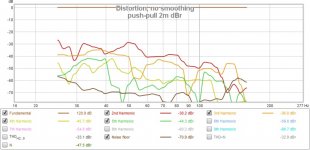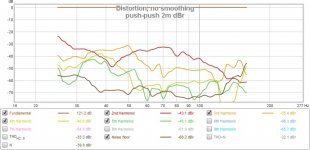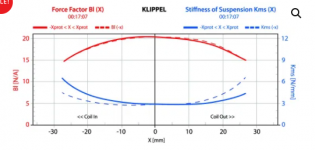Looks like an interesting construction approach! Glad to hear it worked out so well for you. Thanks for sharing it.
I’m aiming for small and inconspicuous, and flat response (as opposed to compensating for lower hearing sensitivity at low frequencies). My excursion-limited calculations suggest I’ll be able to get high enough SPL out of a small box if I don’t run out of amplifier power first.
I’m aiming for small and inconspicuous, and flat response (as opposed to compensating for lower hearing sensitivity at low frequencies). My excursion-limited calculations suggest I’ll be able to get high enough SPL out of a small box if I don’t run out of amplifier power first.
I’ve been reading up on push-pull slot-loaded subwoofers. Has anyone seen distortion measurements on the Dayton Reference “high output” drivers? I’m trying to predict whether the push-pull driver arrangement would yield enough advantage to justify the extra enclosure size and complexity. A push-push arrangement would be easier to keep small and also simplify the force-cancelling assembly (just rigidly tie the magnets together). But if push-pull yields an audible improvement I would consider taking on the design challenge.
Few
Few
All the shorting rings and stuff don't help below 100hz, compared to push pull.
PiSpeakers Forum - Push-pull versus shorting rings - Wayne Parham, June 21, 2006 at 16:18:33
PiSpeakers Forum - Push-pull versus shorting rings - Wayne Parham, June 21, 2006 at 16:18:33
Thanks for the link! I'll do my homework--I hadn't seen that information before, and it seems highly relevant.
Welcome.
I think the distortion reduction would have been higher if the drivers were closer together.
I think the distortion reduction would have been higher if the drivers were closer together.
Am I misreading the online reports? I’ve seen some showing relatively small distortion reductions from push-pull arrangements, and others showing a larger effect. Clearly it would make sense that drivers with symmetry issues would benefit most, but do the benefits scale simply with the magnitude of the second harmonic distortion? I could argue that such a correlation would make sense, but then things are rarely that simple.
Am I misreading the online reports? I’ve seen some showing relatively small distortion reductions from push-pull arrangements, and others showing a larger effect. Clearly it would make sense that drivers with symmetry issues would benefit most, but do the benefits scale simply with the magnitude of the second harmonic distortion? I could argue that such a correlation would make sense, but then things are rarely that simple.
Yeah, I think the higher reduction is because they compare it with a single driver.
with balanced drive (wavecor) the speaker has little distortion.
the immense additional space and optics is difficult to justify.
Certainly the box vibration is reduced, a good weight can have the same effect
Last edited:
Hi Bansuri,
Which case are you referring to? The audioroundtable.com link provided by Norman Bates indicates it's comparing dual woofers on a baffle to push-pull woofers on a baffle (figure attached). I'm probably misinterpreting your post. Apologies in advance.
In my post I had in mind post #758 on this thread. I've attached screenshots of the push-push and push-pull measurements compared there.
Few
Which case are you referring to? The audioroundtable.com link provided by Norman Bates indicates it's comparing dual woofers on a baffle to push-pull woofers on a baffle (figure attached). I'm probably misinterpreting your post. Apologies in advance.
In my post I had in mind post #758 on this thread. I've attached screenshots of the push-push and push-pull measurements compared there.
Few
Attachments
Few. I refer to this white paper
https://www.wavecor.com/Balanced_Drive_technical_paper.pdf
With drivers designed like this there would be no improvement or very little
The posted measurements were of course made with a driver where the effect is extreme. Also it should be noted that the 5th and higher harmonics increased, may be because of the magnet and frame causing reflections.
Or rather the vent acting like a compression driver to the back
That is what the 758 says, I agree 100%
https://www.wavecor.com/Balanced_Drive_technical_paper.pdf
With drivers designed like this there would be no improvement or very little
The posted measurements were of course made with a driver where the effect is extreme. Also it should be noted that the 5th and higher harmonics increased, may be because of the magnet and frame causing reflections.
Or rather the vent acting like a compression driver to the back
That is what the 758 says, I agree 100%
Last edited:
The cabinet wall vibrations are worse because they affect the fundamental.
Inside the cab the pressure is opposite to the radiated wave and the walls bend and radiate a wave that diminishes the fundamental, apart from resonances at higher frequencies.
I had excellent results with spherical enclosures

Inside the cab the pressure is opposite to the radiated wave and the walls bend and radiate a wave that diminishes the fundamental, apart from resonances at higher frequencies.
I had excellent results with spherical enclosures

Thanks for the link. Very interesting. And it gets at the question I've been trying to probe.
Is there a way, with readily available information, to determine when push-pull will yield enough benefit to warrant the extra complications? So far my answer has been that relevant information is often not available. Sound Integrity takes a stab (attached) but the Dayton Reference HO speakers are just described as "Triple shorting-ring motor for ultra-low distortion."
And underlying all of it is the nagging question of audibility. Geddes and others have argued the importance of harmonic distortion is often exaggerated. I would think that if it's going to be an issue, then fundamentals in the bottom octave, with harmonics at frequencies we can hear better, is where it'll be most important. But I can't support that with data. No doubt it's out there. Too bad I have a day job demanding my attention!
Anyway, thanks again for the posts.
Few
Is there a way, with readily available information, to determine when push-pull will yield enough benefit to warrant the extra complications? So far my answer has been that relevant information is often not available. Sound Integrity takes a stab (attached) but the Dayton Reference HO speakers are just described as "Triple shorting-ring motor for ultra-low distortion."
And underlying all of it is the nagging question of audibility. Geddes and others have argued the importance of harmonic distortion is often exaggerated. I would think that if it's going to be an issue, then fundamentals in the bottom octave, with harmonics at frequencies we can hear better, is where it'll be most important. But I can't support that with data. No doubt it's out there. Too bad I have a day job demanding my attention!
Anyway, thanks again for the posts.
Few
Attachments
- Home
- Loudspeakers
- Subwoofers
- Advice sought: Woofers for compact sealed boxes



